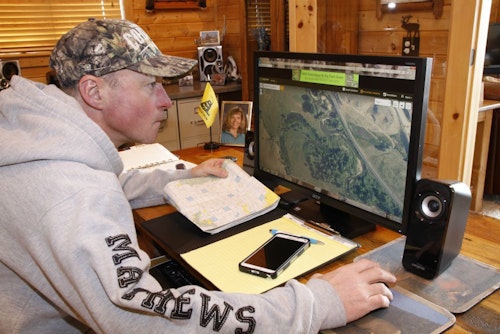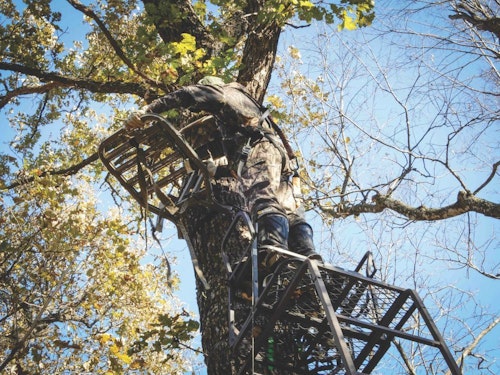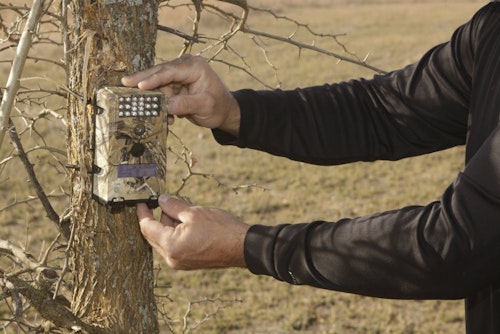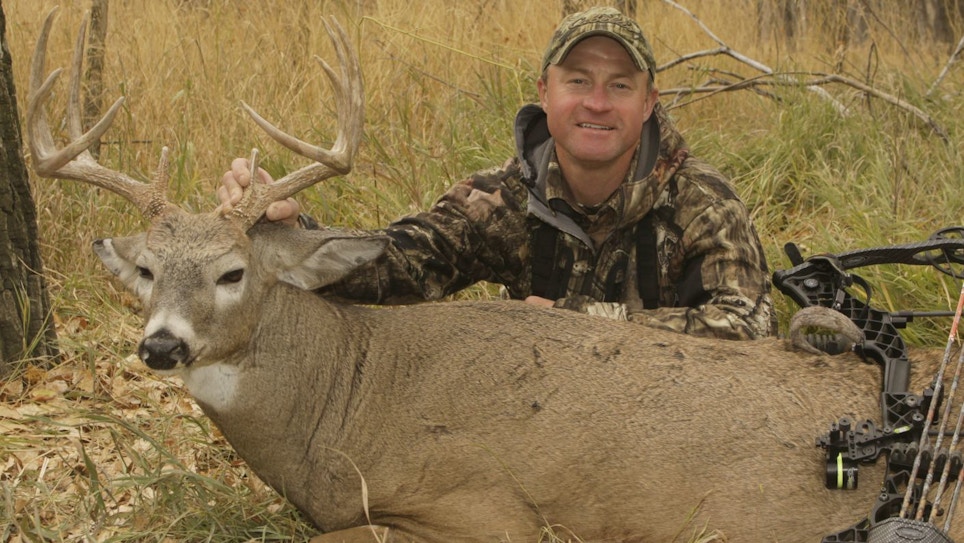The do-it-yourself trend, otherwise known as DIY, continues to inspire bowhunters into hunting the recesses of the American West. If you’re a whitetail fanatic there’s no need to sit on the sidelines as this phenomena plays out. Regardless if you hunt whitetails east or west in a far-off location you can still find DIY success using some of the proven tactics that western bowhunters employ.
It’s becoming more common for bowhunters in average whitetail country to spread their wings and set up operations in trophy-producing states. Iowa, Illinois, Wisconsin, Oklahoma, South Dakota, Kentucky, Ohio and a host of other states have proven track records for putting trophies in the Pope and Young books consistently. If you don’t have a state targeted, the Pope and Young Club is the perfect start for research. Look for states tallying the most entries, but make sure those trophies have been recorded in recent years. A state that was a blockbuster in the 1970s may be waning today just like psychedelic-colored shirts of that era.
After you settle on a regional goal, rack your brain to come up with any human connections in those areas. Think family and friends, but don’t overlook business associations, worship relationships or other people you may have dealt with in the past. Even think financial where you may have paid someone a big dividend in the past, like a financial advisor. Hint at a payback in the conversation … just saying.
A fallback is the web. Swap hunts, leases, trespass fess and other means of gaining access to prime hunting ground crowd targeted searches. If you can’t find a workable hunting option via these options, then you best stay at home.
Homework
I was just kidding about staying home, but you can begin your homework assignment from the comfort of home. Say you have an uncle managing a farm in Missouri or you leased land in Kentucky. Once you have the GPS coordinates and the green light from the deed holder to set up hunting camp, begin your scouting in front of an aerial, satellite image. Now get on the phone with the land manager. The deed holder may not be the best person to talk with, especially if they are absentee landowners. You need to talk with the person who spends the most time on the land, not the person who hosts the occasional dude outing to the property. Query them on every aspect of whitetail travel, feeding patterns, deer refuge and whitetail usage of the land.
With the land manager’s notes in hand it’s time to get serious about putting the power of the internet to work for you. You can remote scout from afar utilizing satellite imagery. Zooming down from above allows you to see the terrain: Roads, fence lines, fields and riparian zones that make up a property. Even without boots on the ground, understand the power of fields, funnels and cover to attract whitetails — especially when you add in notes from the land manager.
For a more whitetail-focused look at a property you may want to go beyond Google Earth and tap into the power of a hunting app. There are lots out there so check each to see if they match your scouting needs. OnX Maps, HuntStand and others can boost your scouting. I utilize HuntStand for the simple fact it has pinpoint weather for your location, plus it offers some of the best map features.
Regardless of your preference, two major features will make your life easier while scouting from home. First, the app should outline and detail property ownership. Second, it should include overlays on the image with topography — this is an absolute must have. Boundaries help you realize where you can and cannot go and where deer may cross over onto the neighbor’s land. Plus, it provides you with information if you ever need to reach out to a neighbor.
Topography offers a multitude of bonuses. For starters, you can’t always tell elevation or steepness from a satellite image. You may be able to note hills, valleys and very obvious steep terrain, especially in open areas, but hidden terrain under a tree canopy, subtle slopes and other land features that direct deer through a property can be as difficult to see as a U.S. Marine Corps scout sniper team. Topography features allow you to refine your scouting and eliminate negative locations due to terrain blockades. Throughout this home-based scouting session, continue to make notes directly on your app. Mark the location of all farmable fields, timber conduits, bedding habitats and if the area is semiarid, note the location of water.

One-and-Done Travel
As much as you may want to feed your screen-time addiction at home, you should consider one trip to the property before hunting season. Summer is a good time for a getaway. Combine your trip with an amusement park visit, a visit to the relatives (really!) or even a fishing outing. Don’t plan too many extracurricular activities depending on what you want to accomplish.
Your personal goals, budget and what the landowner allows for improvements will dictate your schedule. A buddy of mine lives in Pennsylvania and annually hunts Nebraska. Each year he makes a pilgrimage to the Cornhusker state. For him it’s all about reviewing the ag status of the land, confirming current weather conditions, checking stands and setting up trail cameras that will operate as a scout until he returns. It’s a great strategy to follow.
Begin with a tour hosted by the local land manager. Even if they do not hunt their daily insight on the property reveals much about how whitetails utilize a parcel. Take careful notes again on where they believe deer feed and bed and their main routes of travel. Review any standing crops with a note on approximate harvest. If livestock utilize the property, a footnote on rotation schedules and pasture usage gives you a jumpstart on where to place stands and where to avoid. It doesn’t hurt to ask them about population trends either. Do they feel the current population is up or down, and did they notice any odd mortality?
If things seem to be going well with you and the manager, broach the topic of having them possibly monitor trail cameras for you. If they balk, see if they have children or even a nearby rural youth that may be willing to do the chore. You may not need this deer intern if you have an unlimited budget and service exists for cellular camera operation. Nevertheless, you can set the intern up with extra SD cards and batteries for a camera check once a month while you’re AWOL from the property.
If the landowner permits, you could also till in a small hunting plot at this time and pray for timely, late-summer rains. That project may be a future undertaking, but you could also approach the land manager about purchasing a small corner of standing crops at fair-market value and have them leave it if livestock won’t invade a field. It’s a quick and easy solution to a missing food plot. Don’t forget to discuss baiting either. If legal and green lit by the landowner you can put that intern to work refilling stations after setting up an account at the local co-op. They can refill mineral sites, plus replenish scrape drippers if those also make your to-do list. One last job for your intern is no trespassing signage if it doesn’t exist. Getting the message out early helps would-be gatecrashers make informed decisions later.
It’s still not time to barbecue with that distant cousin. You need to spend a day either resetting stands from yesteryear or putting up new stands. Four stand sites gives you options to move about for varying wind directions or, God forbid, you move at an inopportune moment only to spook a Booner staring at you in coiled, escape mode.
Expect to put in at least two hours at each stand site. New stands require extra trimming, trail preparation and the usual monkey business of swinging from limb to limb due to crazy tree configuration. Erecting four stands will likely take a day and you can combine stand setup with camera placement too. Schedule it into the trip.

Hit the Ground Running
Some of the best whitetail hunters I know stress the importance of reining in your enthusiasm when you arrive in the fall to hunt. Their advice is to spend at least one day confirming deer sign and watching any active fields from afar for real-time evidence.
Targeting a morning and evening field can reveal much about what’s been going on while you’ve been away. Early season archery hunts will definitely focus on fields, with hopes of ambushing bachelor bucks. As the rut nears, aim for the highest density of does, as bucks will undoubtedly be scheduling regular visits.
Your trail cameras, combined with a day of scouting behind you, have hopefully directed you to one or two stands with big-buck potential. Boots on the ground can dial in that hunch further as you inspect edges and a few yards of interior trail inspections for rubs and scrapes. Bring along an extra stand setup or two when you do return to hunt. You can rob one of your pre-existing sets, but whitetail hunting oftentimes becomes a game of chess with the need to reposition, even if it is a 50-yard shift. Take your cameras with you too if you readjust. A new location requires a new set of eyes, especially if you’ve already confirmed activity, or lack thereof, at your old location.
It’s not at all uncommon for deer to shift travel patterns due to farming, unexpected flooding or livestock showing up next door to their favorite sanctuary. As an absentee hunter you need to be adaptable. One season I showed up at a property 500 hundred miles from my home the first week of November. Because of unpredicted dry conditions, the supervisor of the property moved approximately 100 head of cows into a prime stand of timber after weaning. Yes, it was the best pocket of whitetail cover on the farm.
Fortunately, I had a lightweight stand and steps stashed in my truck bed. I also confirmed with a farmhand that a band of thick willows near the river was fenced out to avoid cattle getting bogged down in the river muck. That evening after the deer vacated the thick cover to cross the river to the neighbor’s alfalfa, I invaded. Using a headlamp I hung a stand in the dark and the next morning returned way before shooting light to beat the arriving deer back to their own bedroom.
The rustle of willow limbs below me made me slowly swivel my noggin and a buck sparring with an innocent sapling was the commotion maker. After his faux fight, he continued on the trail below and past me. I already had my Mathews aimed, and a 16-yard quartering away shot confirmed for me that scouting from 500 miles away wasn’t a disadvantage at all.

Sidebar: Trail Camera Must Haves
Scouting afar just got easier. The best innovation for those of us hunting far-off destinations is the refinement of trail cameras with field to phone technology. As cellular service expands across whitetail country and prices continue to drop, there are fewer, and fewer reasons not to try cellular trail cameras. With lithium batteries or solar charging you can expect months of immediate connectivity, and images straight to your smartphone. Cameras don’t clog up with images like SD cards that need to be changed out. And best of all you don’t contaminate an area with scent in the usual, anticipatory enthusiasm of most whitetail camera checkers.
Regardless if you decide to go the cellular route or the SD route, you still need to comparison shop. Since video eats up data we’ll skip that entertainment luxury. Look for trail cameras that operate throughout the lighting periods. Nighttime illumination is best with invisible LEDs and they should be able to illuminate game to 100 yards. You don’t need great resolution for scouting, but 8MP to 16MP is becoming the standard. Trigger speed should be at least .5 seconds to guarantee nothing slips past with a comparable recovery time or less. A three-image burst can help in image capture, but again leads to extra data being used if you’re 500 miles away.
Lastly, if you got traditional make sure the camera can accept a 32GB SD card for maximum storage. Load it up with the best in Lithium batteries and you may not need an intern to oversee camera maintenance.
Photos by Mark Kayser






